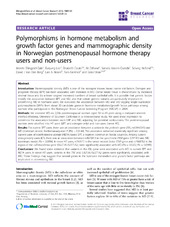| dc.description.abstract | Introduction: Mammographic density (MD) is one of the strongest known breast cancer risk factors. Estrogen and progestin therapy (EPT) has been associated with increases in MD. Dense breast tissue is characterized by increased stromal tissue and (to a lesser degree) increased numbers of breast epithelial cells. It is possible that genetic factors modify the association between EPT and MD, and that certain genetic variants are particularly important in determining MD in hormone users. We evaluated the association between MD and 340 tagging single nucleotide polymorphisms (SNPs) from about 30 candidate genes in hormone metabolism/growth factor pathways among women who participated in the Norwegian Breast Cancer Screening Program (NBCSP) in 2004. Methods: We assessed MD on 2,036 postmenopausal women aged 50 to 69 years using a computer-assisted method (Madena, University of Southern California) in a cross-sectional study. We used linear regression to determine the association between each SNP and MD, adjusting for potential confounders. The postmenopausal women were stratified into HT users (EPT and estrogen-only) and non-users (never HT). Results: For current EPT users, there was an association between a variant in the prolactin gene (PRL; rs10946545) and MD (dominant model, Bonferroni-adjusted P (Pb) = 0.0144). This association remained statistically significant among current users of norethisterone acetate (NETA)-based EPT, a regimen common in Nordic countries. Among current estrogen-only users (ET), there was an association between rs4670813 in the cytochrome P450 gene (CYP1B1) and MD (dominant model, Pb = 0.0396). In never HT users, rs769177 in the tumor necrosis factor (TNF) gene and rs1968752 in the region of the sulfotransferase gene (SULT1A1/SULT1A2), were significantly associated with MD (Pb = 0.0202; Pb = 0.0349). Conclusions: We found some evidence that variants in the PRL gene were associated with MD in current EPT and NETA users. In never HT users, variants in the TNF and SULT1A1/SULT1A2 genes were significantly associated with MD. These findings may suggest that several genes in the hormone metabolism and growth factor pathways are implicated in determining MD. | en_US |

